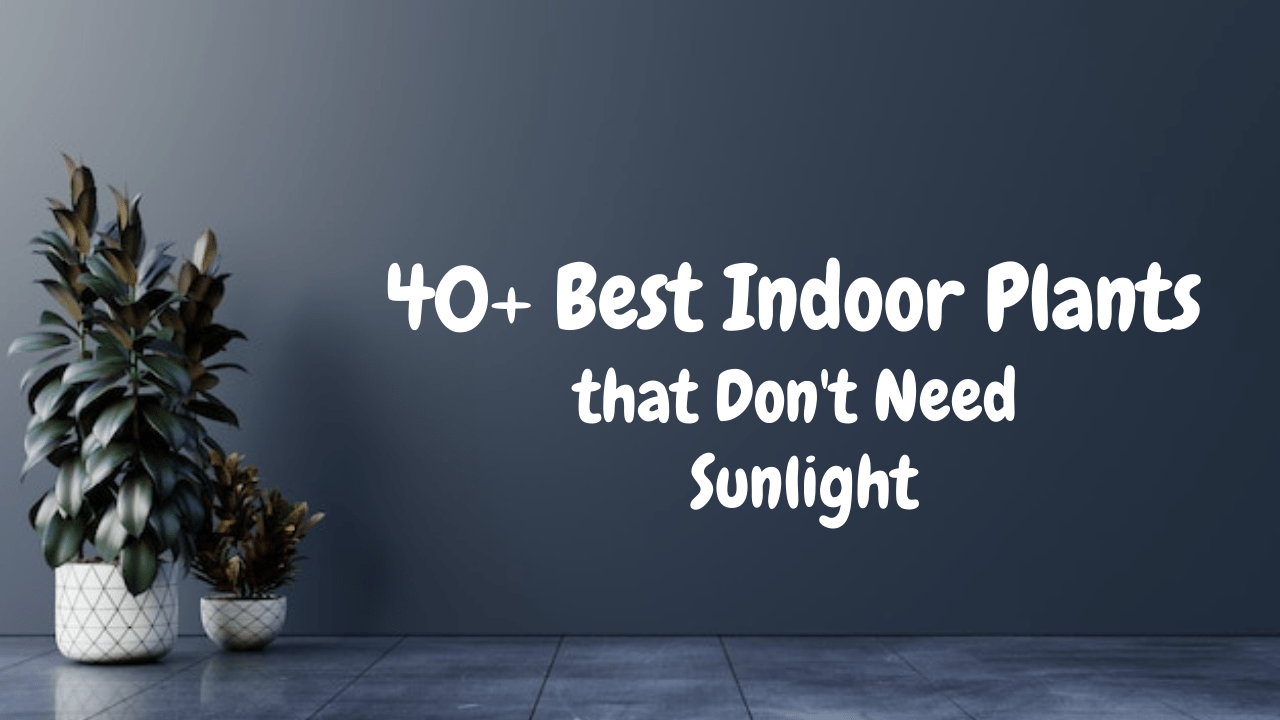Having sun reaching your apartment’s indoor spaces is ideal, but not every apartment is fortunate enough to get brightened by natural light. In this situation, we rely on lamps and lights to brighten up the space, but artificial lights can’t remove the gloominess of the dark corners of your house. A simple solution is to provide your sun-deprived apartment with plants that don’t need sun. The natural green will instantly elevate your home’s liveliness.
Does your home lack direct sunlight? Don’t let these shady reasons keep you from having a green companion indoors. Here’s a list of 40 indoor plants that don’t need sun.
Best Indoor Plants that Don’t Need Sunlight
1. Bromeliad

Common Name: Bromeliad
Native Area: Tropical and subtropical Americas
Botanical Name: Bromeliaceae genera
Family: Bromeliaceae
Soil Type: Fast-draining potting soil
If you are looking for some brightly colored flowers, Bromeliads is the one for you. They’re a popular indoor plant due to their distinct appearance and tropical atmosphere. Depending on the various species, these plants look perfect on shelves, tabletops, or even the floor.
Usually, most of the bromeliad species prefer bright indirect sunshine. These are one of the best indoor plants that don’t need sunlight. Thus it can easily survive on indirect light.
Direct sunlight can scorch the leaves of a bromeliad due to prolonged exposure to direct sunlight. You can keep these plants close to a window, but not directly in front of it. If you don’t have any natural light, these can thrive under fluorescent lights too.
2. Chinese Evergreen

Common Name: Chinese evergreen, Philippine evergreen
Native Area: Asia
Botanical Name: Aglaonema commutatum
Family: Araceae
Soil Type: Peaty, well-drained
Even the most inexperienced “house gardener” can seem like a pro with the Chinese Evergreen. Chinese evergreen plants are one of the numerous indoor plants that don’t need sunlight.
Older Chinese evergreens produce flowers that resemble calla lilies, and they look best on the floor adjacent to furniture and in open spaces in the home.
If you have small Chinese evergreens, they are an ideal pick to decorate a desk, tabletop, or shelf. The color of its leaves determines the solar requirements of the Chinese evergreen. These indoor plants without sunlight are also on NASA’s list of air-filtering houseplants.
These are both easy to care for and healthy choices for your home!
3. Corn Plant

Common Names: Corn plant, dracaena, false palm
Native Area: Africa (tropics)
Botanical Name: Dracaena fragrans
Family: Asparagaceae
Soil Type: Moist, well-draining, loamy
If you are looking for something totally indestructible, you won’t regret the Dracaena Tree. These typical houseplants require little maintenance. Corn plant comes in a variety of colors, and you can place them on shelves, tables, and floors, making an excellent addition.
The more significant kinds, such as the dracaena massangeana, have a tree-like appearance and are ideal for use as floor decor. Dracaenas thrive in bright, indirect light and are one the best indoor plants without sunlight. These best air-purifying plants remove toxins from the home to an extent.
4. Dumb Cane Plant
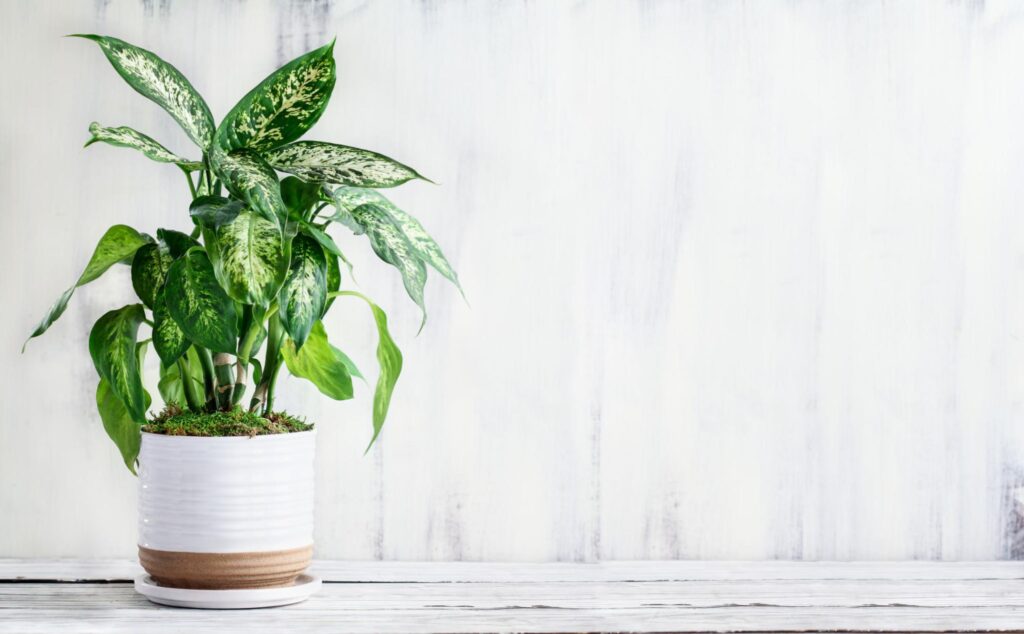
Common Names: Dieffenbachia, dumb cane
Native Area: Caribbean, South America
Botanical Name: Dieffenbachia spp.
Family: Araceae
Soil Type: Peaty, well-drained potting soil
Looking for a taller indoor plant that doesn’t require much light? You can place these indoor plants without sunlight in both your home and office.
Because of their poisonous nature, they’re known as ‘stupid canes.’ All portions of the plant are dangerous to both pets and children, so it’s better to keep them away from it.
But why is it so popular if it’s poisonous?
Dumb cane is appreciated for its ability to grow up to 5 feet tall and its gorgeous, striped leaves. Dumb canes flourish in low-light environments, preferring filtered light, and are one of the best indoor plants that don’t need direct sunlight.
5. Cast Iron Plant
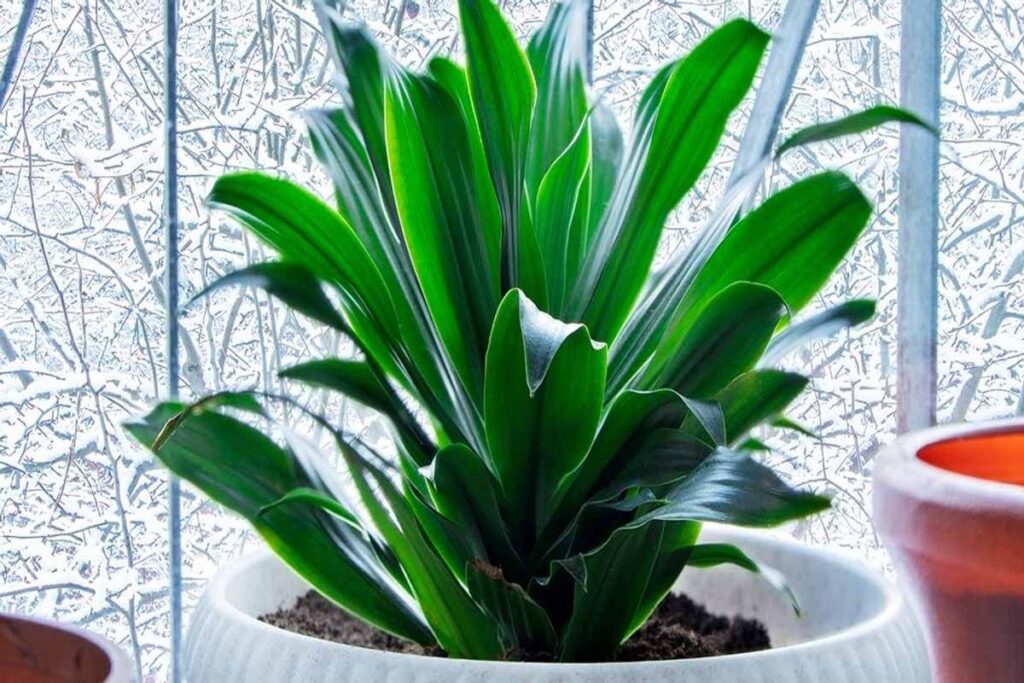
Common Name: Cast-iron plant, bar room plant
Native Area: Asia
Botanical Name: Aspidistra elatior
Family: Asparagaceae
Soil Type: Well-drained
These indoor plants without sunlight are also known for their hardiness. The cast-iron plant is ideal for professionals who are always on the go and don’t have time to take care of their plants. It’s a robust, flowering plant that’s also relatively simple to grow indoors.
The deep green leaves of cast iron plants add a natural glimpse to any part of the space.
These are low-light plants that can flourish in practically any surroundings. Cast iron plants take a long time to develop, yet they are extremely challenging to kill. You should keep these indoor plants that don’t need sunlight away from scorching rays to prevent the browning of their leaves.
6. English Ivy
Common Name: common ivy, English ivy, European ivy
Native Area: Europe, Scandinavia, Russia
Botanical Name: Hedera helix
Family: Araliaceae
Soil Type: Fertile and moist
Want to transform your space into a work of art? English ivy is an excellent climbing plant that can become the talk of a room. These indoor plants without sunlight look beautiful on trellises, fences, and other structures where their vines can flourish.
Although English ivy prefers indirect light, it may still thrive in dim light. The more indirect light this indoor plant gets, the more vibrant the color of its leaves will be. Direct sunlight, on the other hand, can kill it.
7. Parlor Palm
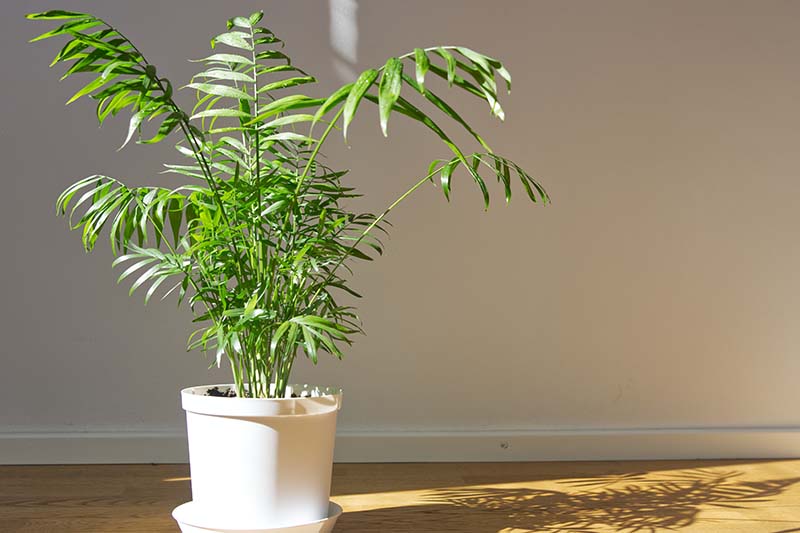
Common Name: Parlor palm, Neanthe bella palm
Native Area: Rainforests of southern Mexico and Guatemala
Botanical Name: Chamaedorea elegans
Family: Arecaceae
Soil Type: Peaty soil-based potting mix
Parlor palms are lush plants that work well in dining or living rooms. People used to consider these indoor plants that don’t need sunlight as a sign of wealth for a family. The parlor palm adds a classy touch to any area it occupies.
Parlor palms usually prefer medium lights over low light. They also prefer shadier settings over brighter areas, so don’t put them too close to a window. If you have artificial light, parlor palms can thrive well.
8. Peacock Plant

Botanical Name: Calathea Makoyana
Native Area: Brazil
Common Name: Peacock Plant, Cathedral Windows
Soil Type: Moist but well-drained
Who isn’t amazed by the beauty of peacock feathers? These indoor plants that don’t need sunlight resemble the beauty of peacock feathers. Because of its gorgeous foliage and striking markings, this houseplant can be a lovely addition to your home design.
These indoor plants are known for being striking and selective when it comes to their maintenance. Humidity and moist (but not damp) soil are all favorites of these indoor plants without sunlight.
Peacock plants require low to medium light and will develop unhappy leaves if exposed to too much direct light.
9. Maidenhair Fern Plant
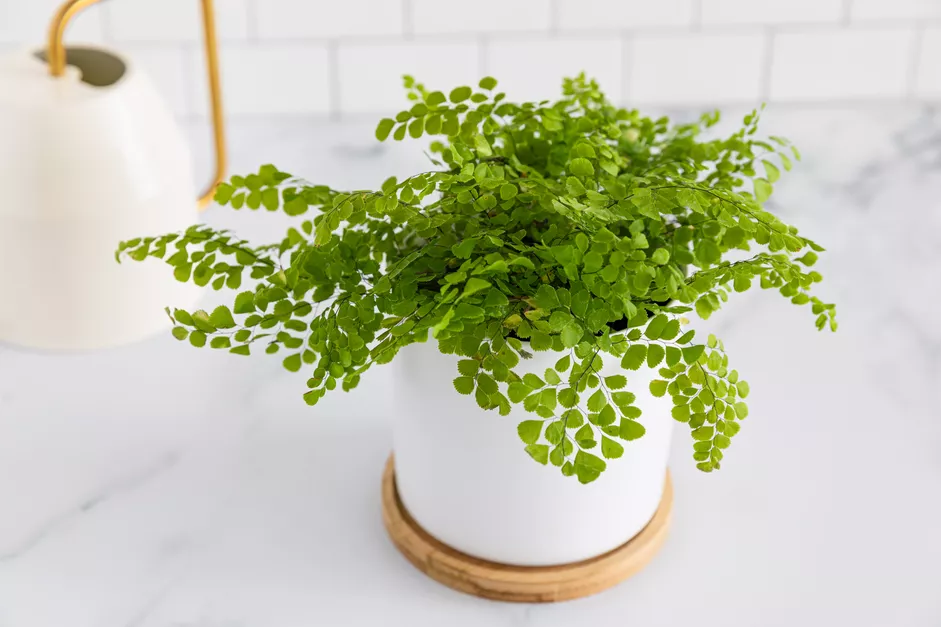
Common Name: Maidenhair fern, Delta maidenhair fern
Native Area: North America
Botanical Name: Adiantum raddianum
Family: Pteridaceae
Soil Type: Moist but well-drained
Maidenhair fern plants are lovely plants that add elegance to any area, but they’re also relatively easy to kill! However, these indoor plants that don’t need sun are worth the additional effort due to their beautiful foliage and appearance.
Direct sunlight can kill maidenhair ferns, so they prefer indirect, bright light. These maidenhair ferns also require high humidity and despise dry soil, so try to keep them damp but not soggy to prevent root rotting.
10. Peace Lily
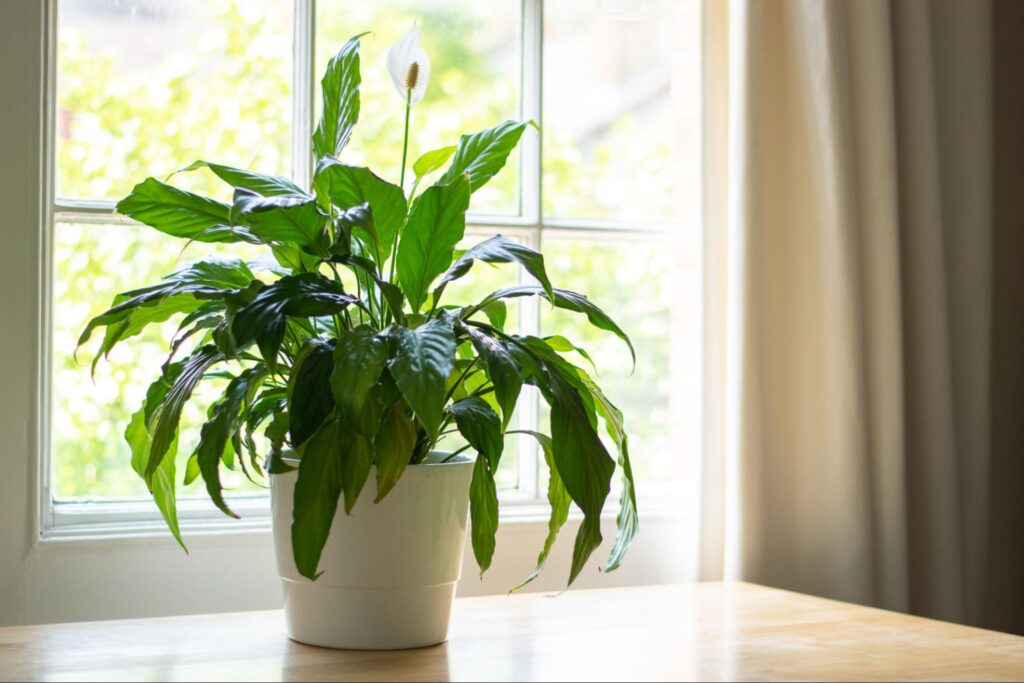
Common Name: Peace lily, Spath lily
Native Area: Central America, Asia
Botanical Name: Spathiphyllum spp.
Family: Araceae
Soil Type: Moist but well-drained
Contrary to popular perception, a peace lily is not a true lily. The white “petal” sprouts around the yellow bloom is a leaf bract. Next time you see one, look closely at these indoor plants without sunlight!
Low to medium light is perfect for these indoor plants. These can do well under fluorescent light. The more light the lilies receive, the more white blooms they will deliver.
They can survive in low-light environments but are less likely to blossom. The peace lily is known for its distinctive feature of air-purifying quality.
11. Pothos
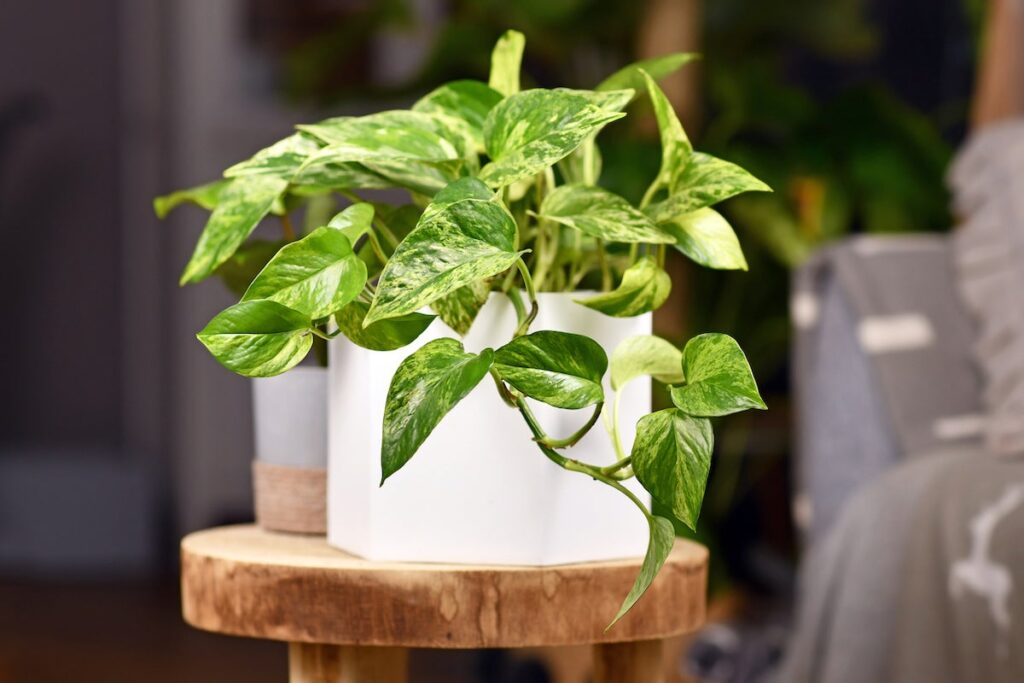
Common Name: Devil’s ivy, Golden pothos, devil’s vine
Native Areas: South Pacific
Botanical Name: Epipremnum aureum
Family: Araceae
Soil Type: Moist but well-drained
If you are new to gardening, pothos will help you with its low care. Pothos may produce long, captivating vines that can be used to glorify walls and give any space a tropical vibe. As a result, these indoor plants that don’t need sunlight are best suited as hanging plants or potted on a desk.
Pothos plants thrive inside medium to low light, although they may survive in low light. Their leaves can turn yellow if exposed to too much direct light, while their gorgeous foliage will turn pale if exposed to little light.
12. Peperomia
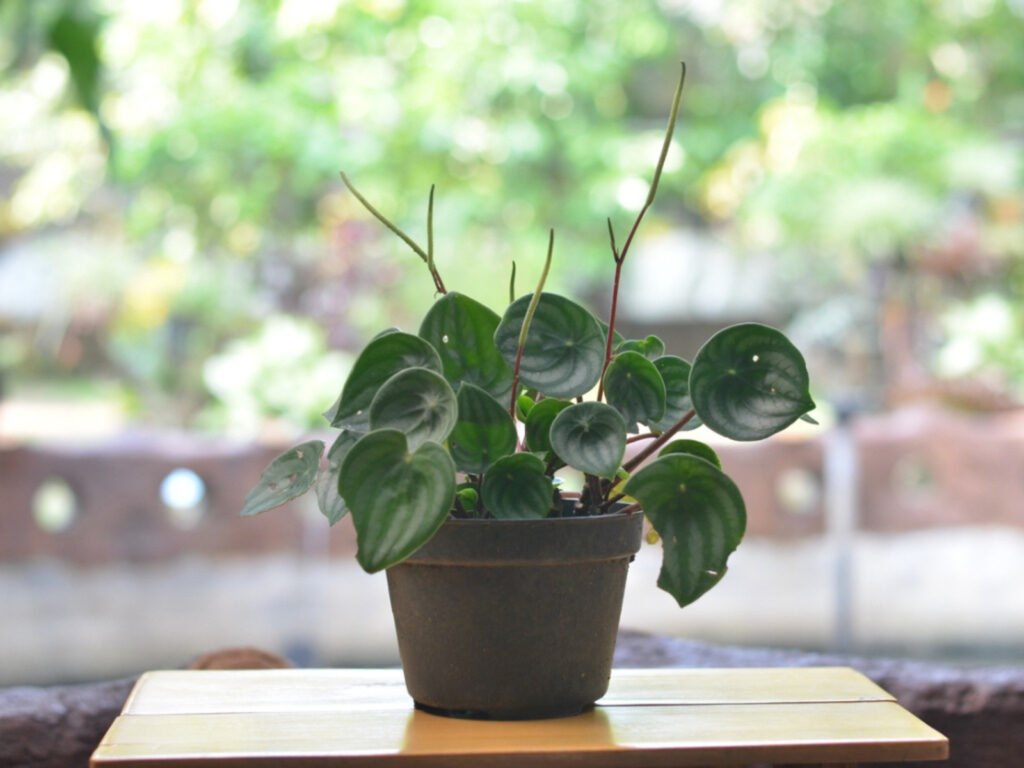
Common Names: Emerald ripper pepper, Baby rubber plant, radiator plant, pepper elder shining bush plant,
Native Area: Central and South America, and the Caribbean
Botanical Name: Peperomia spp. (including P. caperata, P. obtusifolia, and others)
Family: Piperaceae
Soil Type: Moist but well-drained
Peperomia are small plants that add a splash of pigment to your desk or table. Peperomia is a lovely indoor plant with thick, meaty leaves and attractive foliage. It’s a low-maintenance, slow-growing plant that enjoys dampness and somewhat moist soil.
These plants enjoy dry soil and may last a few days without being watered. The leaves are grey, crimson, cream, and green in color.
These indoor plants without sunlight thrive in bright, indirect light but can also thrive in fluorescent lighting. If necessary, Peperomias can thrive in slightly shaded regions. To avoid scorched leaves, keep your peperomia away from direct sunlight.
13. Prayer Plant
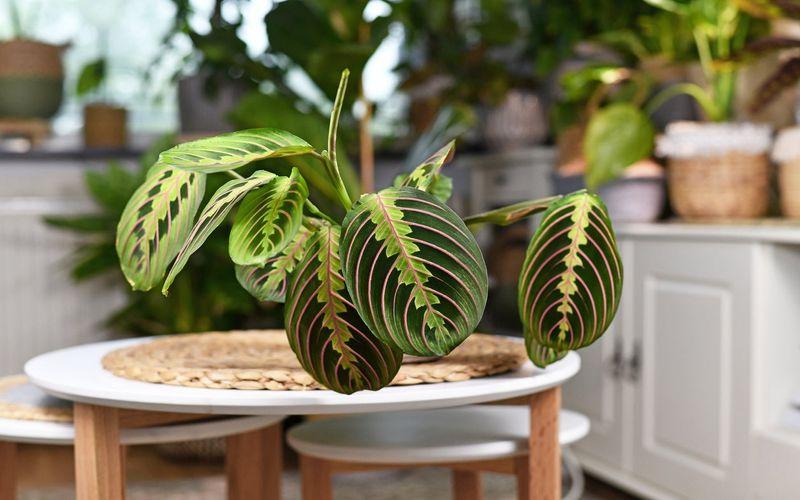
Common Name: Prayer plant
Native Area: South America
Botanical Name: Maranta leuconeura
Family: Marantaceae
Soil Type: Moist but well-drained
Are you looking for something extraordinary to add to your collection of indoor plants that don’t need sun? Prayer plants will do the rest. When night falls, the prayer plant leaves fold up like hands, ready to pray.
The pink veins and oval leaves stand out from the crowd quickly. Known for their distinctive leaves, these plants look lovely in hanging baskets.
Prayer plants adore indirect light and can also succeed well in low-light environments. However, if the prayer plant’s leaves do not receive enough light during the daytime, they might close and not reopen in the evening. Try to maintain moist soil and high humidity.
14. Bird of Paradise
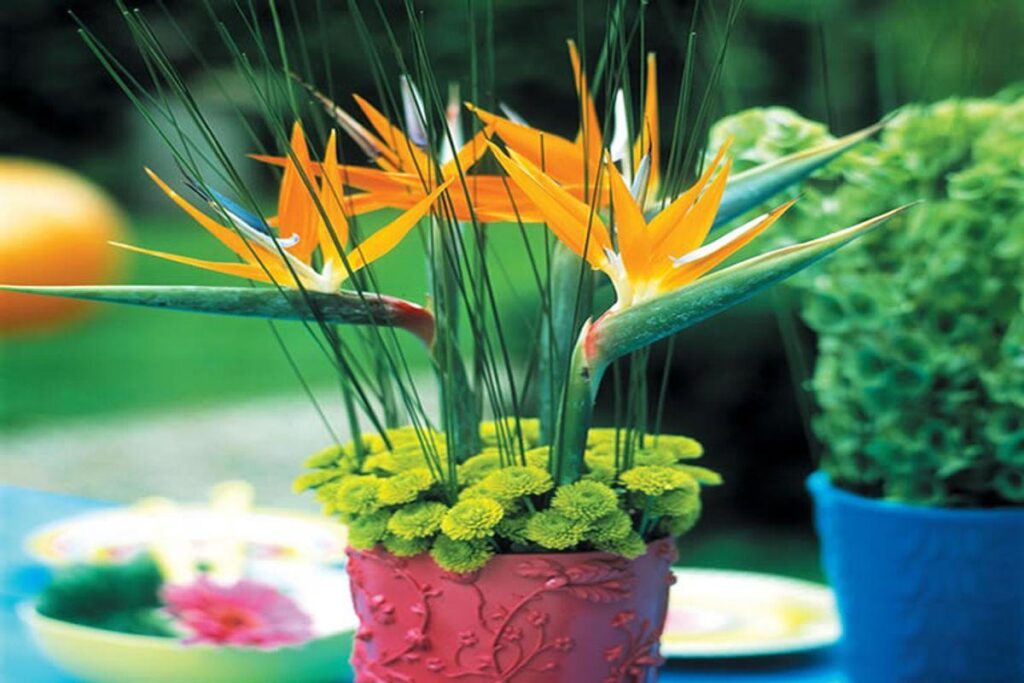
Common Name: Bird of paradise, crane flower
Native Area: Africa (South Africa)
Botanical Name: Strelitzia reginae, Strelitzia nicolai
Family: Strelitziaceae
Soil Type: Loamy
Could we introduce you to the plant that will eventually outshine your indoor garden? A bird of paradise offers a tropical appearance but requires less upkeep than the previously described flora.
This low-light indoor plant can take five or more years to bloom, but its large leaves will give your home a tropical feel indoors.
These indoor plants that don’t need sun are ideal for adding an appealing aura to any space. Make sure sufficient drainage is in place because you want the soil to be wet but not waterlogged. Water your bird of paradise when the dirt on top appears to be dry.
15. Philodendron
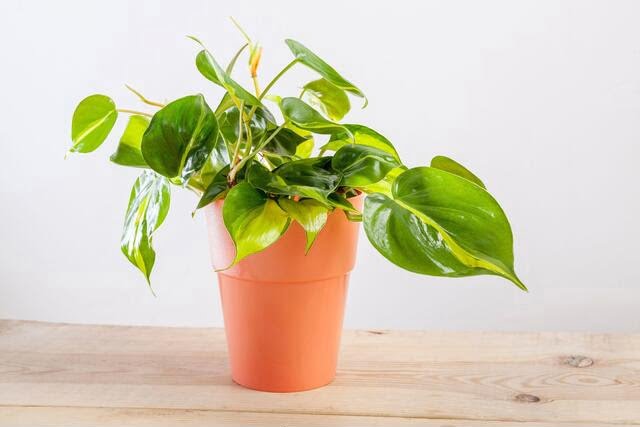
Botanical Name: Philodendron bipinnatifidum, Thaumatophyllum bipinnatifidum
Native Area: South America
Common Name: Tree philodendron, Philodendron selloum, lacy tree philodendron, horsehead philodendron
Soil Type: Loamy, moist but well-draining
Philodendrons are statement plants known for their vibrant foliage and distinctive appearance. The heartleaf philodendron, in particular, is a hardy plant that can thrive in a variety of situations with little to no attention, including low light.
These indoor plants that don’t need sunlight come in climbing and non-climbing forms, and with proper care, they may reach heights of three feet and widths of six feet. They love bright, indirect light, although they can also grow in moderate shade.
16. Lucky Bamboo
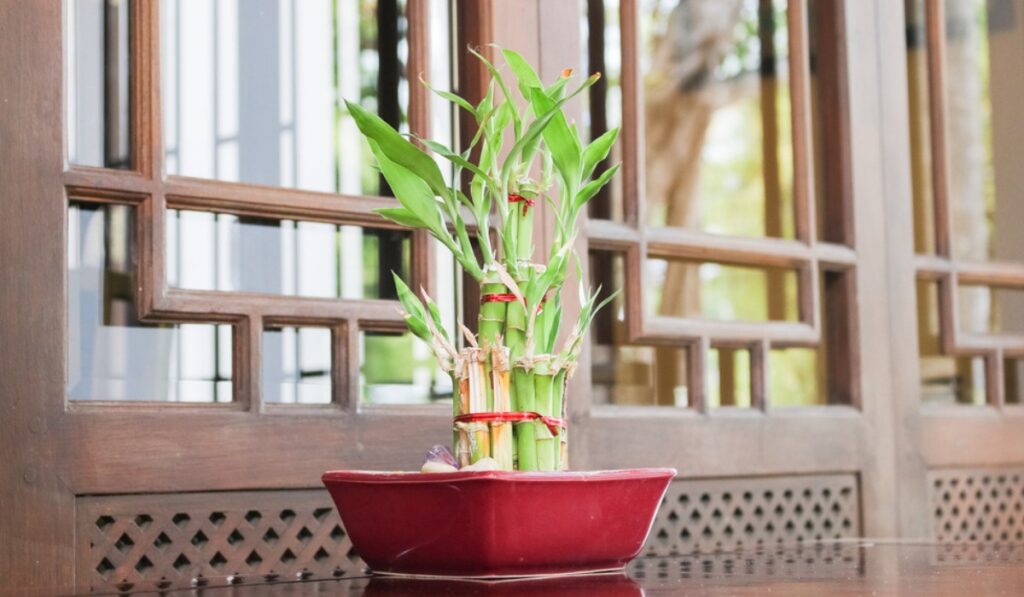
Common Name: Friendship bamboo, Lucky bamboo, ribbon plant
Native Area: Africa
Botanical Name: Dracaena sanderiana
Family: Asparagaceae
Soil Type: well-drained soil
This plant attracts positive energy and good fortune, according to Feng Shui. It’s one of the best plants for office desks and tables. Because of its compact form, you can grow it in water without fear of light exposure in your home.
These are one of the best indoor plants that don’t need sunlight. These bamboo plants are excellent gifts and may be grown in both water and soil.
17. Rex Begonia
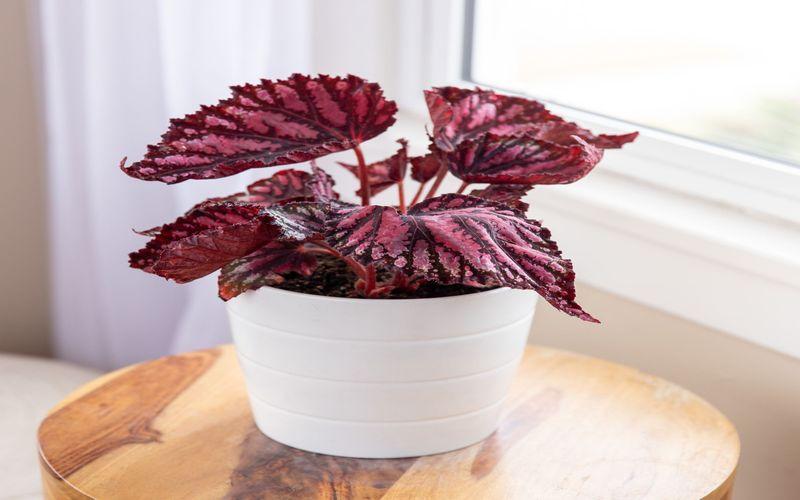
Common Name: Rex begonia
Native Area: East India, southern China, and Vietnam
Botanical Name: Begonia rex-cultorum
Family: Begoniaceae
Soil Type: Porous
Rex Begonias are known for their spectacular foliage. If you are keen to add colors, textures, and shapes to your indoor plants without sunlight collection, rex begonia wins the battle. Its leaves come in a variety of shapes and sizes, including hearts, seashell swirls, ivy-like formations, and more.
The Rex Begonia is distinguished by its vibrant hues, which are frequently a mix of green, pink, or burgundy, as well as metallic tints of greyish silver. It’s always a sight to witness! Rex Begonias are care-friendly indoor plants that won’t give you much trouble.
18. Monstera

Common Names: Split-leaf philodendron, Swiss cheese plant, window leaf, ceriman
Native Area: Central America
Botanical Name: Monstera deliciosa
Family: Araceae
Soil Type: Peat-based potting soil, well-drained
Monstera, also popular as the swiss cheese plant, boasts large, robust, heart-shaped leaves with fascinating holes or splits that emerge as the plant ages. This plant thrives in any light, but it likes to climb, so be sure to give a trellis or moss-covered stick.
These indoor plants that don’t need sun are incredibly low on maintenance and are often pest-free. You can treat pests as soon as they develop on Monstera plants by spraying a natural insecticide like neem oil and wiping down the plant regularly.
19. Boston Fern
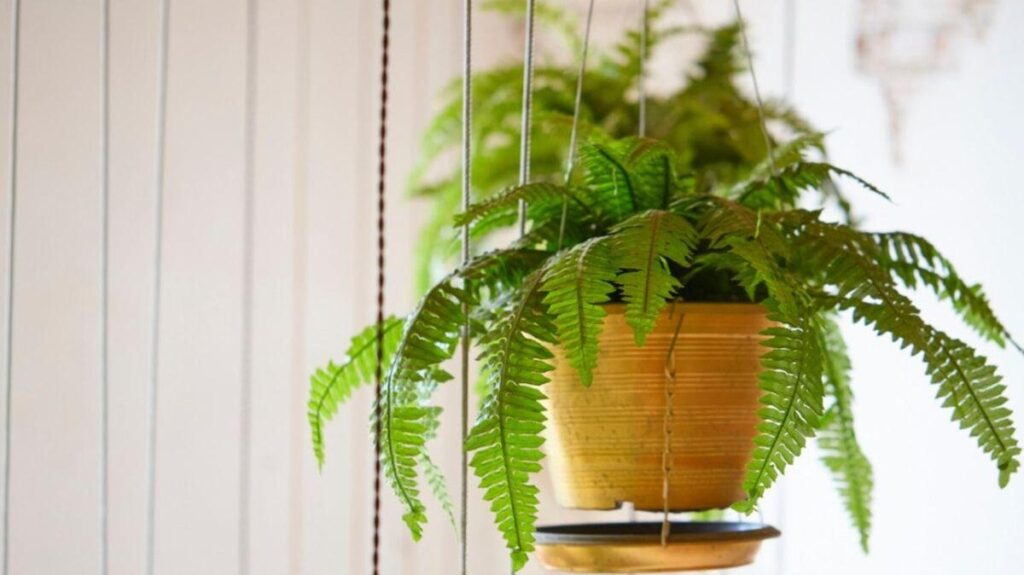
Common Names: Sword fern, boss fern, ladder fern
Native Area: Americas, Africa, Polynesia
Botanical Name: Nephrolepis exaltata
Family: Lomariopsidaceae
Soil Type: Moist, well-drained
Boston ferns are drought-resistant houseplants that are easy to grow. You can use them to improve the appearance of your study area or office by planting them. These plants prefer indirect soil that is slightly damp drains well, and is acidic.
Ferns offer the space’s texture, intrigue, and beauty with their delicate lacy appearance. These indoor plants that don’t need sunlight have bright green, blade-like fronds that can grow up to 4 feet long characterize this plant. Gardeners love it since it’s a low-maintenance addition to the landscape.
20. Snake Plant
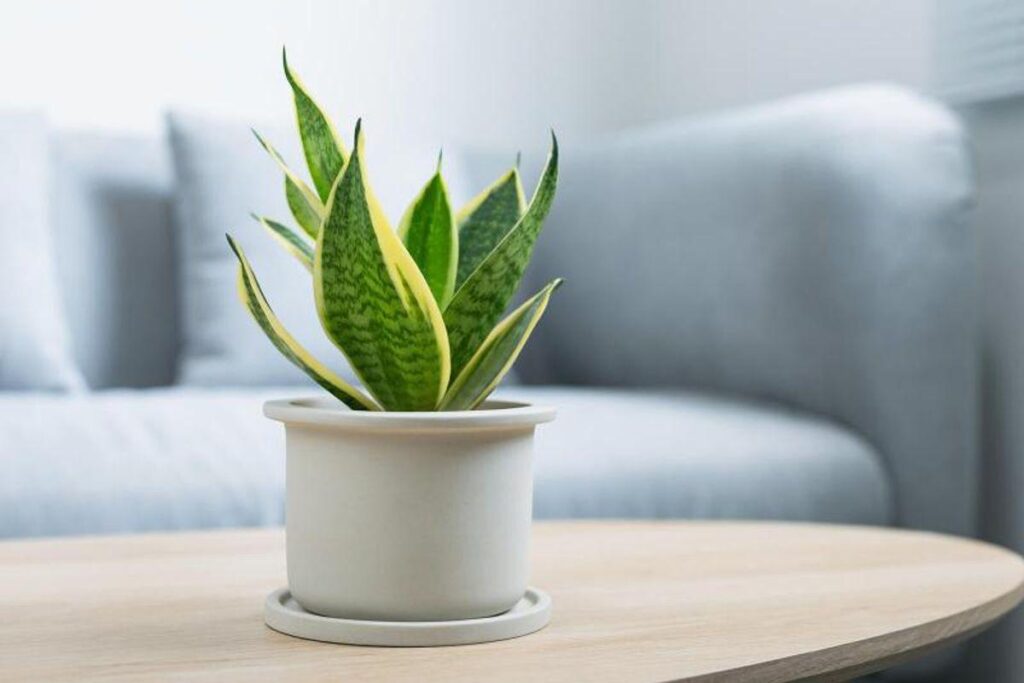
Common Name: Snake plant, viper’s bowstring hemp, St. George’s sword
Native Area: West Africa (tropical)
Botanical Name: Dracaena trifasciata (formerly Sansevieria trifasciata)
Family: Asparagaceae
Soil Type: Sandy, well-drained
Snake plants are incredibly tolerant of neglect and ideal for tucking into that awkward corner distant from a window. Their cool, modern pointed leaves with variegated colors appear stunning in a tiny pot or a large planter.
The sharp point of the leaf is said to be the source of this term. People gave it the name “snake” plant because of its striped color, which resembles the skin of a snake. These plants can withstand even the most negligent green plant parents.
Snake plants can maintain their strong appearance even after a few weeks of neglect.
21. Zebra Cactus

Common Name: Haworthia, zebra cactus, pearl plant, star window plant, cushion aloe
Native Area: Africa
Botanical Name: Haworthia
Family: Asphodelaceae
The Zebra Cactus (known for its attractive white spots) is a succulent that blooms with tiny white-brownish flowers in the early summer and is similar in appearance to the Aloe plant. These are one of the best indoor plants without sunlight.
These plants are adorable miniature succulents that make excellent houseplants. These tiny, low-growing plants create rosettes of mushy green leaves with white pearly warts or bands that give them a characteristic appearance.
22. Paper Plant
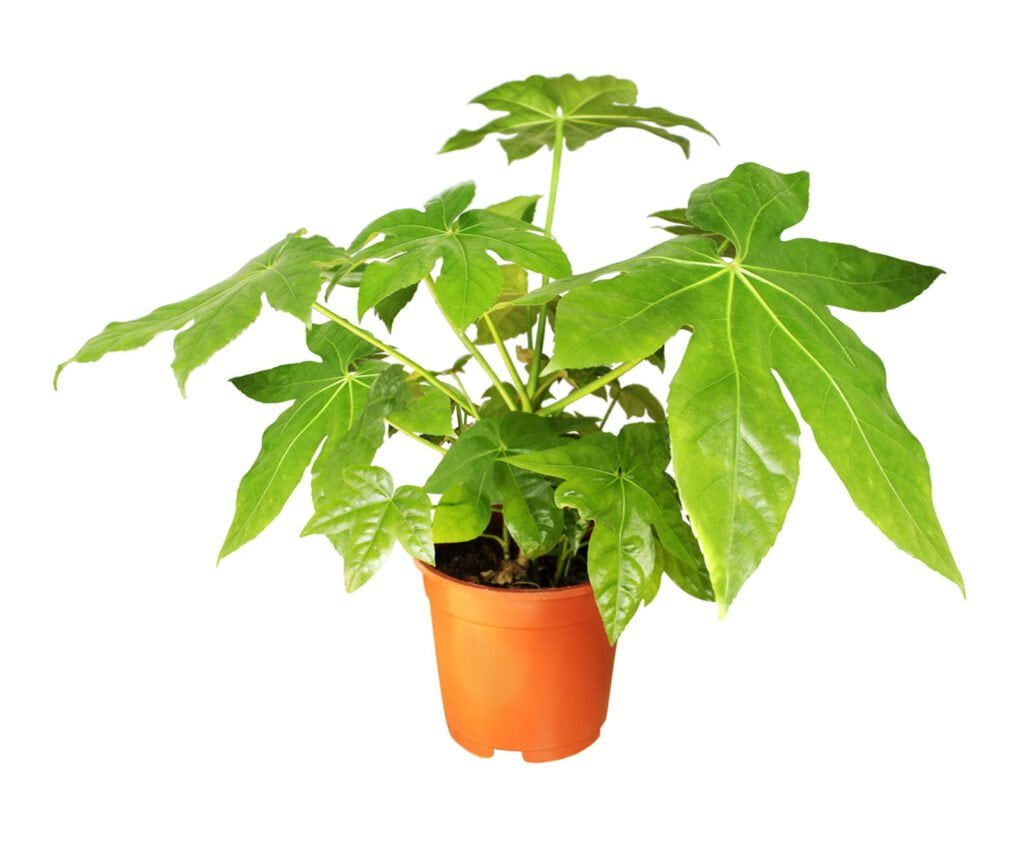
Botanical name: Fatsia japonica
Common name: Japanese aralia
Family: Araliaceae
Soil: well-draining soil
The term “paper plant” comes from its leaves being highly delicate (like paper) and susceptible to cold and dry conditions. These indoor plants that don’t need sun look excellent on the table tops and desks.
They make a perfect addition to any space with their unique leaves. Keep an eye out for fading leaves, which indicate too much sun.
23. Spider Plant

Common Names: Spider ivy, ribbon plant
Native Area: Central and Southern Africa
Botanical Name: Chlorophytum comosum
Family: Asparagaceae
Soil Type: Loamy, well-drained
Who isn’t a fan of keeping unique things at home? Spider plants with long, slender leaves arch outward from their roots to create a unique look. It has spider-like legs on its leaves.
When properly cared for, these indoor plants without sunlight can produce small white flowers and sprout spiderettes or baby spider plants that can be repotted to produce more spider plants.
Spider plants prefer bright, indirect sunlight but can survive in low-light conditions. These indoor plants can thrive in a mix of fluorescent and natural light. If these plants are kept in bright sunlight for a longer duration, it can cause the browning of leaves. It is a result of water fluoride exposure. Watering your plant on a regular basis will help prevent browning and keep it looking healthy.
24. Orchids
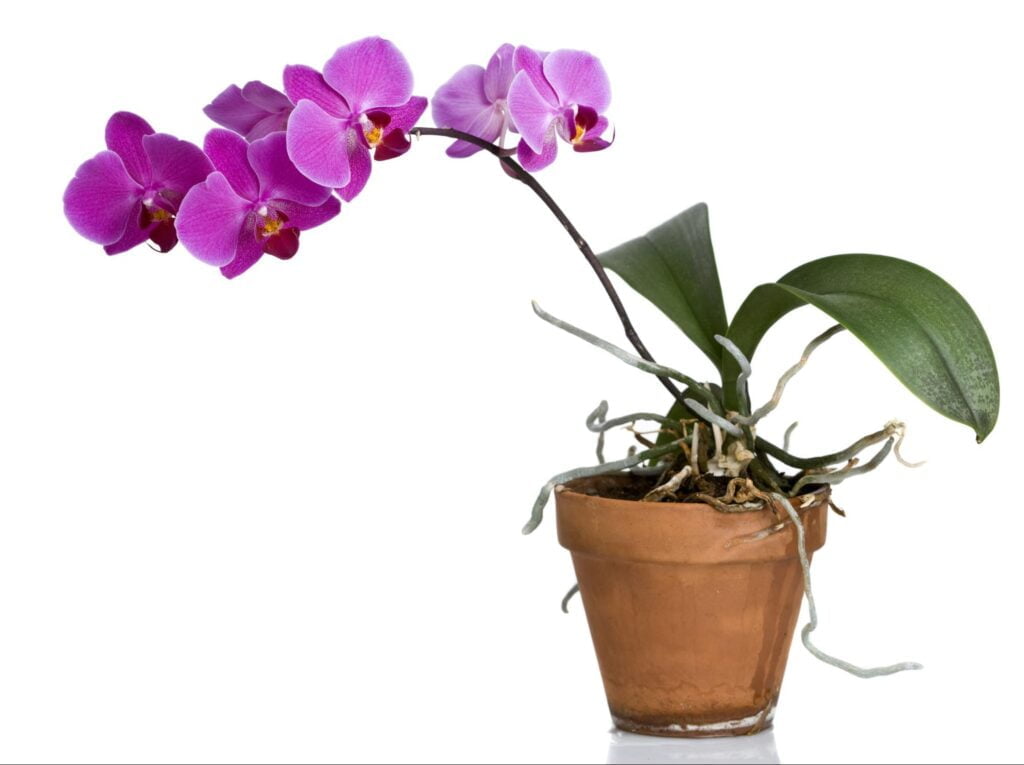
Common Name: Orchids, cane orchids, moth orchids
Native Area: United States, Thailand, and other tropical regions worldwide
Botanical Name: Orchidaceae
Family: Orchidaceae
Soil Type: Sphagnum moss, bark mix, etc.
Orchids are among the most popular indoor plants that don’t need sunlight. They’re inexpensive and come in a variety of forms and floral colors.
Exotic and graceful orchids are your greatest pick when it comes to indoor plants that don’t need sun, as they come in a number of colors, variations, and enchanting aromas!
25. Baby Rubber Plant
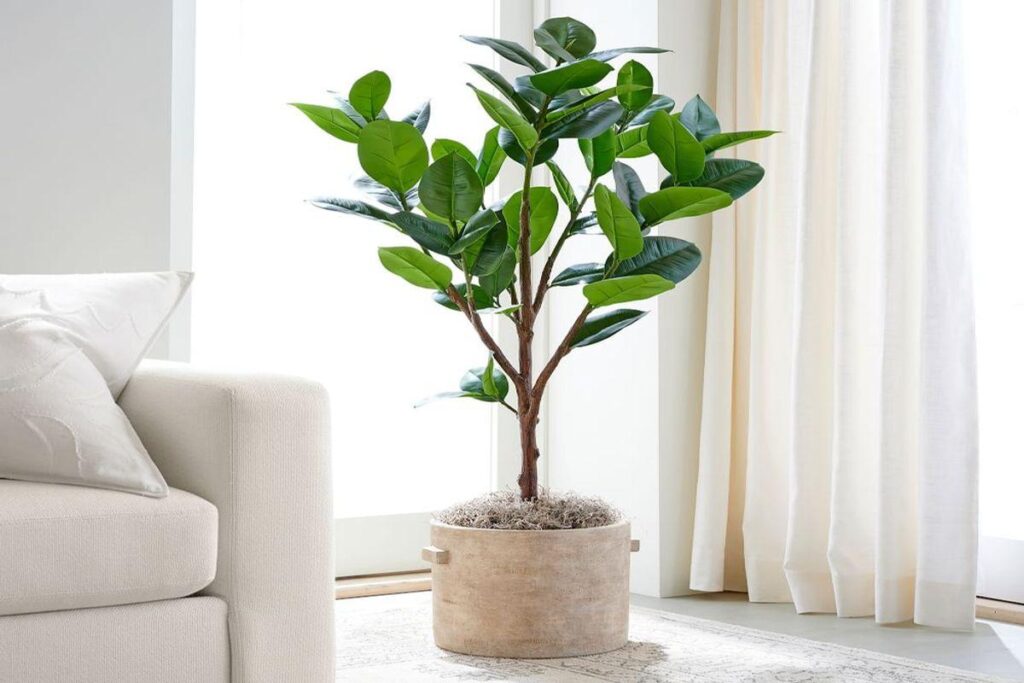
Common Name: pepper face plant, baby rubber plant
Native Area: South America
Botanical Name: Peperomia Obtusifolia
Family: Piperaceae
Soil Type: Clay, Sand, Loam
Looking for a tropical-looking, low-maintenance houseplant? With the baby rubber plant, you can’t go wrong. This pet-friendly, humidity-loving plant is normally grown indoors. This epiphytic species is not related to the rubber plant, despite its common name.
With the baby rubber plant, it’s all about the leaf. These indoor plants that don’t need sunlight are glossy, spoon-shaped, meaty, succulent-like leaves that are typically dark green. You can find cultivars with white and green marble-like variegation.
These plants’ tall stems can trail over time, and their epiphytic roots cling to surfaces effectively, making them perfect for use in hanging baskets or on shelves in living rooms or kitchen areas.
26. Hoya

Botanical Name: Hoya carnosa
Native Area: Tropical Asia, Australia
Common Name: Hoya, wax plant, wax flower, Indian rope plant, porcelain flower, honey plant
Soil Type: Well-draining
Want to add something eye-catching and attractive to your home? Hoya blooms are styled like mophead hydrangeas and grow in a ball-shaped cluster. Each cluster can have up to 40 distinct flowers crammed into a small space.
Individual blossoms appear to be flawless. The common names come from the fact that they appear to be made of wax or porcelain. The corona of many flowers has a colorful eye in the middle.
Woody stems with waxy leaves are produced by the plants, which remain evergreen. A hoya plant can be trained as a vine or allowed to trail over the container’s side. Hoya will look great in any space, whether it’s a tiny or huge one. Hoya indoor plants that don’t need sunlight can easily be grown in rooms with indirect lighting.
27. Staghorn Fern
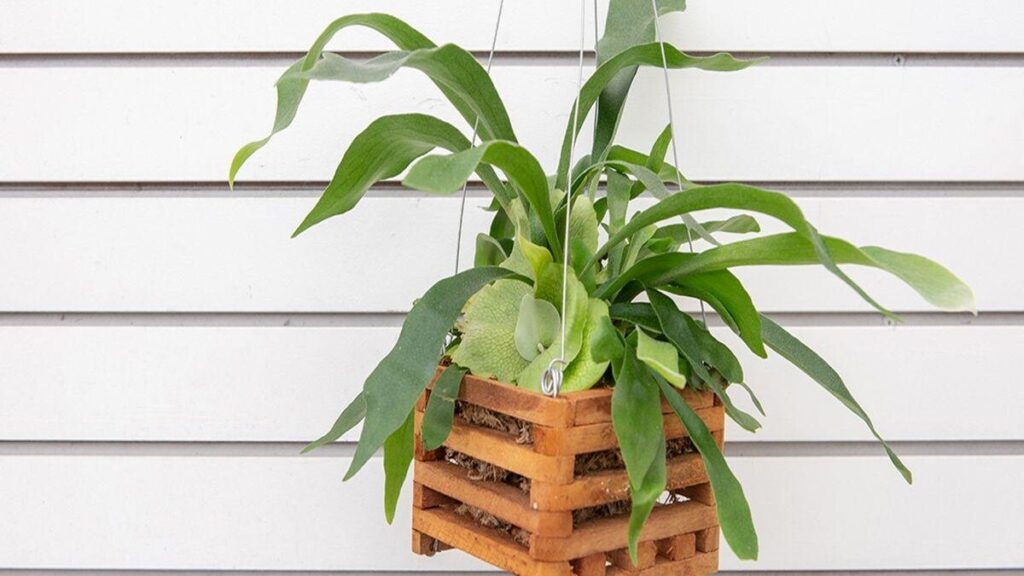
Botanical Name: Platycerium bifurcatum
Native Area: Asia, Australia
Common Name: Staghorn fern, elkhorn fern
Soil Type: Epiphytic
These are showy plants that are a little fussy about their living surroundings. These indoor plants that don’t need sunlight are ideal if you want a low-light plant with a distinctive appearance.
These staghorn ferns do not enjoy direct sunlight and prefer bright, indirect, or filtered light. Because this plant cannot survive in artificial light, arranging it where it will receive the most natural sunshine without blocking the sun’s beams is advisable. Staghorn fern prefers moist but not extremely damp soil.
28. Climbing Fig
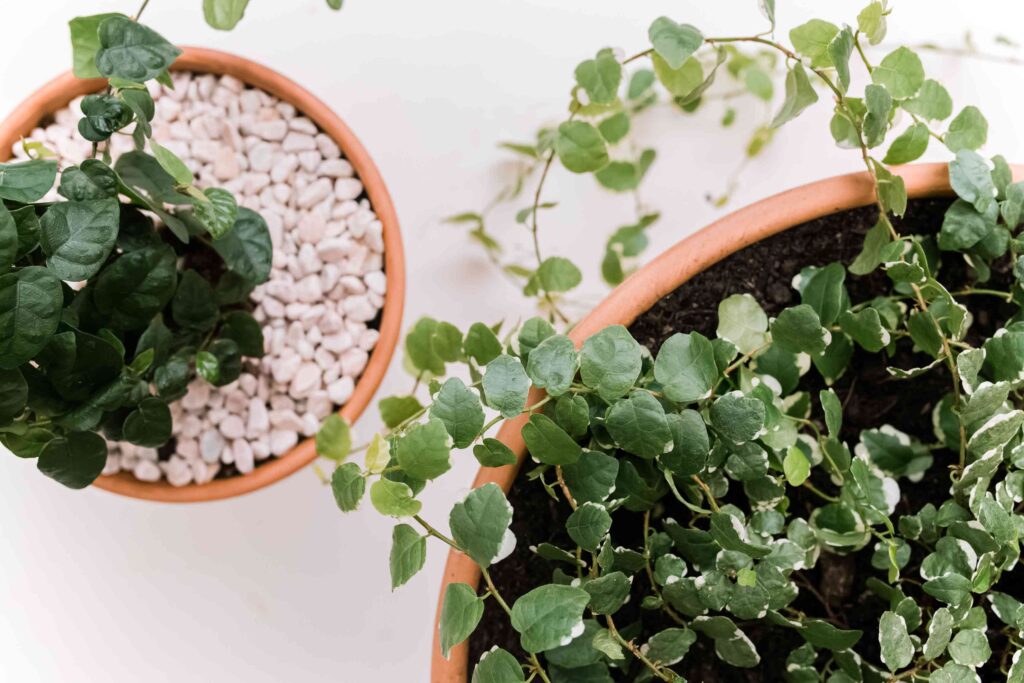
Common Name: Creeping fig, climbing fig
Native Area: Asia
Botanical Name: Ficus pumila
Family: Moraceae
Soil Type: Well-drained
Climbing fig is a lovely small houseplant that’s great for indoor design and ornamentation. As a young indoor plant, a creeping fig has little heart-shaped glossy leaves on thin stems. They’re lovely and simple to cultivate and are relatively robust houseplants that can endure a wide range of conditions, even delicate negligence.
These creeping fig indoor plants that don’t need sunlight are quick climbers that may survive rigorous trimming.
29. Areca Palm
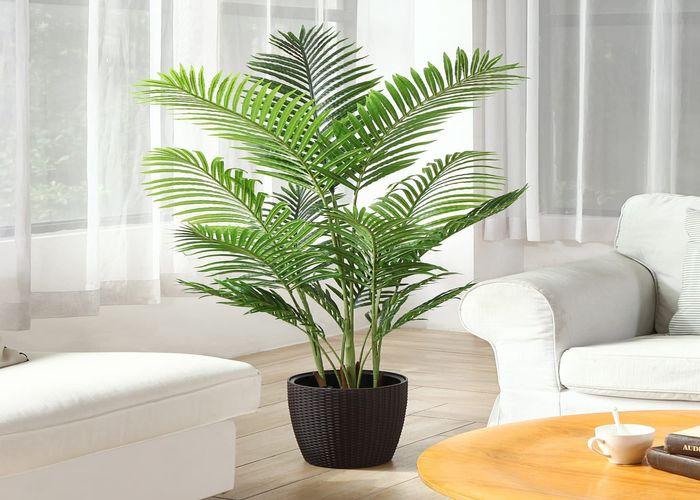
Common Names: Bamboo palm, yellow palm, golden cane palm
Native Area: Madagascar
Botanical Name: Dypsis lutescens (formerly Chrysalidocarpus lutescens)
Family: Arecaceae
Soil Type: Moist, well-drained
Another lovely, evergreen plant to grow at home is the Areca palm. You can place these indoor plants that don’t need sunlight near a window facing east or south. They look adorable on table tops or corner tables.
The smooth, occasionally golden trunks of these palms resemble bamboo bunches. Their fronds are similar to bamboo leaves in that they are slender and full.
30. Aloe vera

Common Name: Aloe vera
Native Area: Africa
Botanical Name: Aloe barbadensis miller
Family: Asphodelaceae
Soil Type: Sandy
Who isn’t aware of aloe vera these days? The thick lance-shaped leaves with jagged edges that grow out of a basal rosette characterize this tropical succulent.
Aloe vera is known for its numerous benefits like soothing sensitive skin, curing minor burns, and relieving itching, among other things. Simply cut a large mature leaf in half, squeeze out the gooey insides, and apply it to your skin.
It removes the pollutants benzene and formaldehyde from indoor air, making it an ideal plant for your home’s hub. These plants only need indirect bright light to survive. Water your aloe vera only when it is completely dry.
31. ZZ Plant

Common Name: Zanzibar gem, eternity plant
Native Area: Eastern Africa
Botanical Name: Zamioculcas zamiifolia
Family: Araceae
Soil Type: Well-draining
The ZZ plant is one of the most trouble-free plants on the planet and is practically impossible to kill. It is one of the best indoor plants if you are looking for luxuriant green foliage and robust nature.
These indoor plants that don’t need sunlight have waxy leaves that give them a lustrous sheen. It’s an excellent plant to have if you want to fill in a blank space in your home or add to your collection of friends.
It prefers bright, indirect light but may also survive in low light. It can even survive in environments with little natural light and only a few fluorescent bulbs. ZZ plant dislikes direct sunlight. Too much light can cause yellowing and curling of leaves if exposed to too much.
32. Arrowhead Vine

Botanical Name: Syngonium podophyllum
Native Area: South America, Mexico
Common Name: Arrowhead vine
Soil Type: Moist but well-drained
The plant gets its name from the spade-like formation of its leaves. The Arrowhead is a fast-growing, luxuriant plant that produces new leaves in colors ranging from dark green with prominent white variegation to lime and even pink.
These indoor plants without sunlight have erect clusters of stems that define young arrowhead plants and are attractive.
33. Weeping Fig
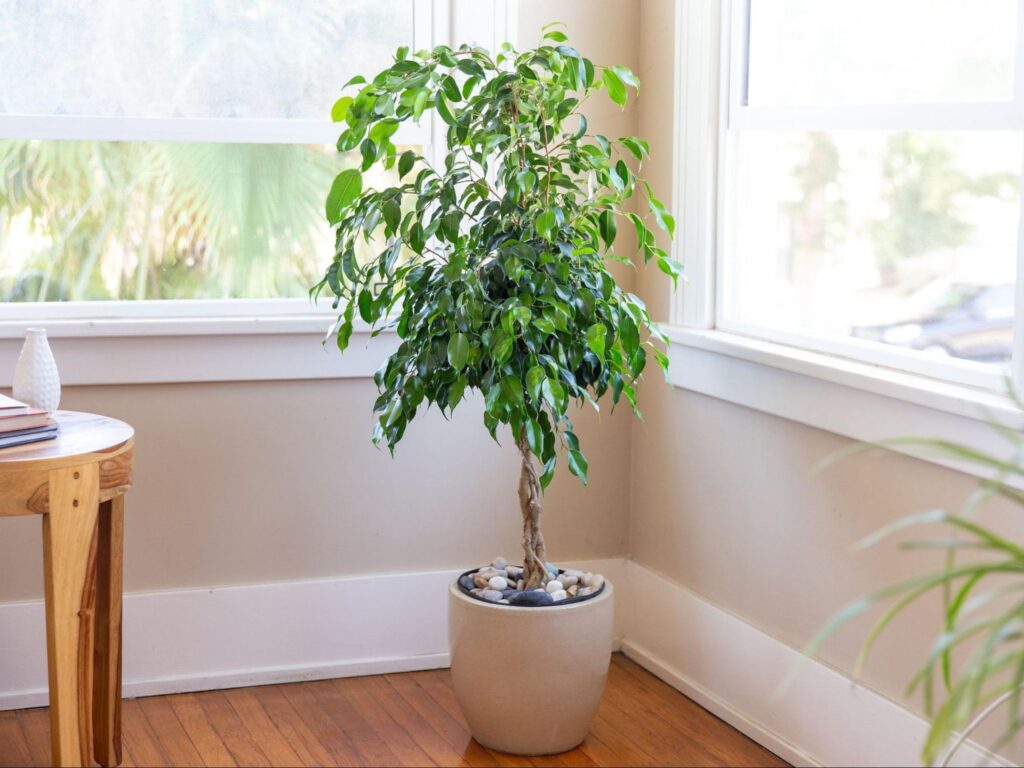
Common Name: Weeping fig, Benjamin fig, ficus tree
Native Area: Asia, Australia
Botanical Name: Ficus Benjamina
Family: Moraceae
Soil Type: Rich, fast-draining potting soil
These indoor plants that don’t need sun look lovely indoors, with their wide arching branches and long pointed leaves. The Benjamina is one of this genus’s most popular tiny indoor trees, with a modest growth rate.
With dense, glossy dark foliage, this adorable plant has slender branches that curve gently from a light grey base. Green leaves, variegated varieties, and small-sized trees (indoor bonsai) can grow up to 3 feet tall.
These make an excellent addition in standing within corners, seated inside a patio, or near a fireplace. People also use them for decorative purposes. The smaller fig and bonsai varieties can be placed anywhere there is adequate space (shelves, table tops).
34. Dragon Tree
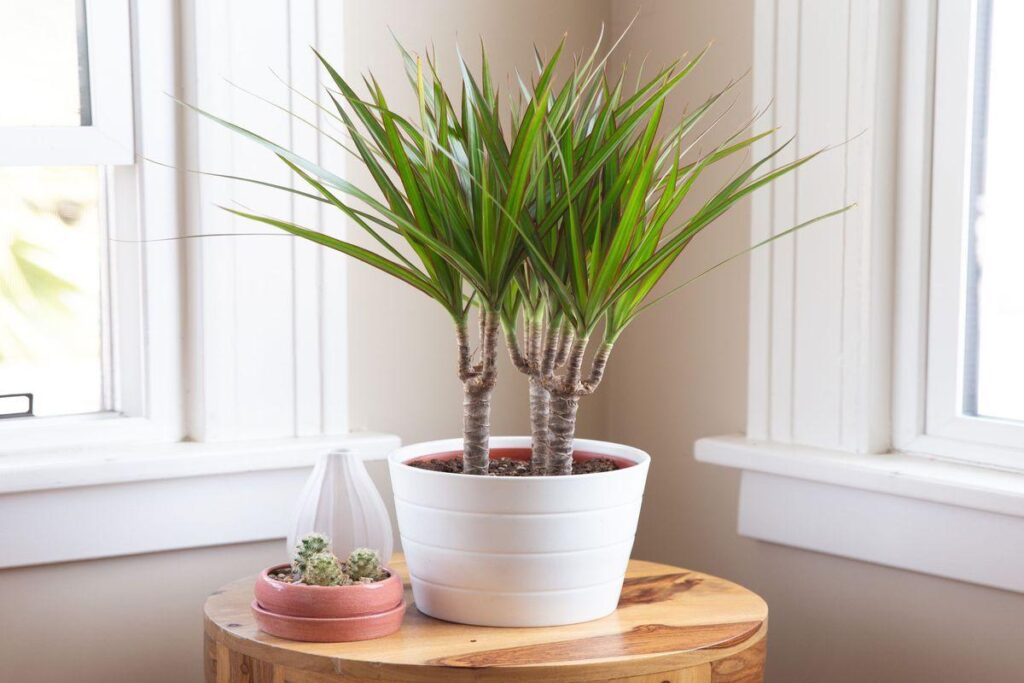
Botanical Name: Dracaena draco
Native Area: The Canary Islands, northwest coastal Africa
Common Name: Dragon tree, Drago
Soil Type: Any well-drained, porous soil
The dragon tree has long, pointed leaves on stems that arise from a large trunk, forming a palm-like canopy. It possesses the one most crucial feature for indoor foliage: it is extremely robust. These indoor plants that don’t need sun have red color on the corner of the leaves, making them more appealing.
It is a species that grows slowly but lives a long time. The dragon tree’s sluggish growth can be an advantage for an indoor plant, as it will take many years to exceed its space.
35. Anthurium
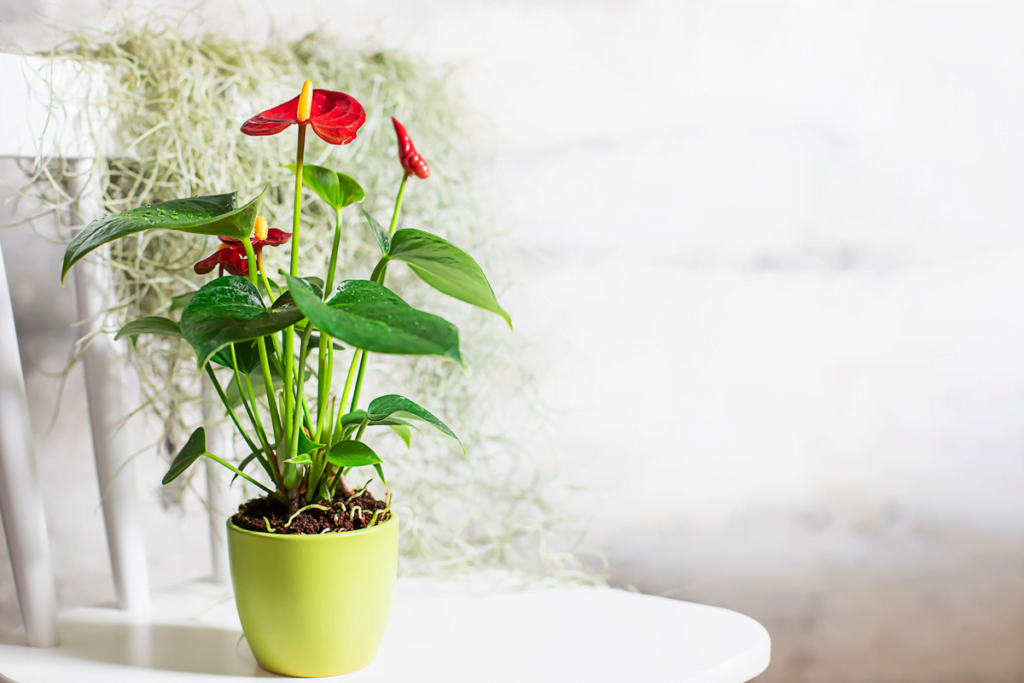
Common Names: Anthurium, tailflower, flamingo flower, laceleaf
Native Area: Central America, South America, Caribbean
Botanical Name: Anthurium spp.
Family: Araceae
Soil Type: Coarse, moist potting mix
They’re famed for their vividly colored flowers, which are actually modified waxy leaves rather than flowers! The more ‘flowers’ this plant can generate, the brighter the indirect light it receives. These are one of the best indoor plants without sunlight.
You should remove any dead or dying foliage and keep this plant away from radiators and air conditioners to keep it happy and healthy.
Like other blooming plants, the anthurium will go through blooming cycles, with a few months of no showy “flowers” followed by a few months of showy “blooms.” Usually, each flower has an eight-week lifespan that creates a statement.
36. Japanese Sago Palm

Common Name: Sago palm, king sago, cycad, Japanese sago
Native Area: Asia
Botanical Name: Cycas revoluta
Family: Cycadaceae
Soil Type: Sandy, moist but well-draining soil
This plant is for you if you reside in a warm temperature zone or are searching for a new addition to your indoor plants without sunlight. It is dark green and lush with strong foliage.
At maturity, the pinnate leaves are roughly four to five feet long, reaching their maximum length when cultivated in partial shade.
Shiny, fresh leaves sprout in a circular pattern from the top of the crown, which is placed atop a woody trunk. Sago palms prefer a warm, sunny climate, while direct sunlight can harm the leaf. As long as the bottom of the plant container does not touch the water, you can place it on a tray filled with water and pebbles.
37. Rattlesnake Plant

Common Name: Rattlesnake plant, rattlesnake calathea
Native Area: South America
Botanical Name: Goeppertia insignis, formerly Calathea lancifolia
Family: Marantaceae
Soil Type: Moist but well-drained
However, the leaves do more than just make this plant tall; they also add to its attractiveness. They’re attractively marked with a variety of green tones, wavy edges that emphasize those shades, and green specks that seem like little leaves.
It is distinguished from other calathea species by its elongated, crimped leaves and distinctive foliage pattern. These indoor plants that don’t need sun have dark green markings on a light green backdrop, wavy margins, and a deep purple underside characterize the long spear-shaped leaves, making them unique.
38. Elephant Ears
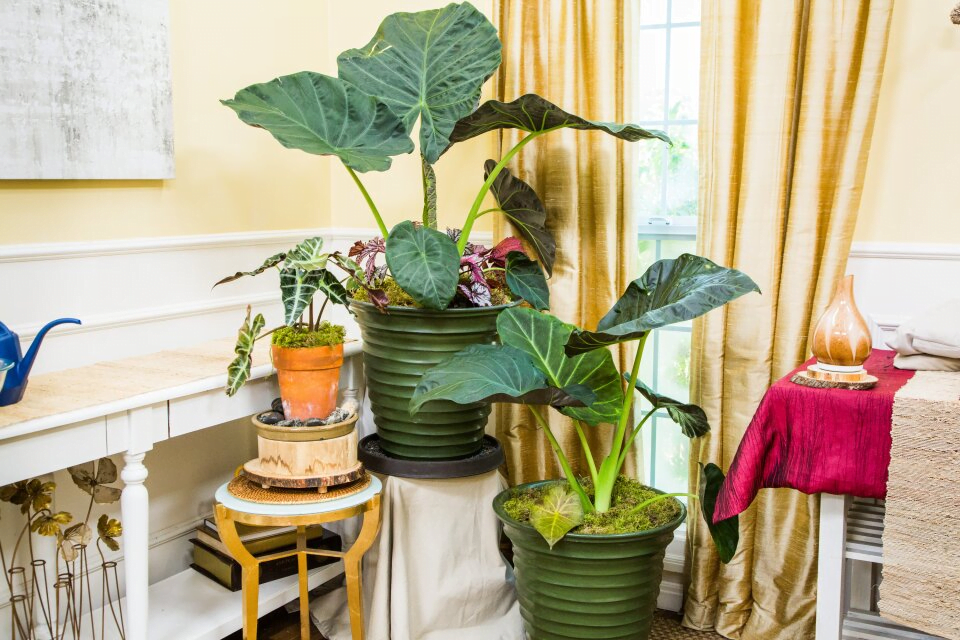
Common Name: Elephant ear, taro, coco yam
Native Area: Asia, Australia, Central America, South America, Africa
Botanical Name: Colocasia, Alocasia, Xanthosoma spp.
Family: Araceae
Soil Type: Moist
Elephant ears are tropical perennial plants that are grown more for their huge leaves than for their flowers. These fast-growing plants reach full size in two months and are typically planted in the spring after the threat of frost has passed and soil temperatures have warmed.
You can also plant these indoor plants that don’t need sunlight later in the summer or early months.
Elephant ears are dramatic, exotic plants with gigantic heart-shaped leaves that are used as accent plants or as a feature in tropical-themed water or bog gardens, depending on the species. They’ll stay smaller indoors, but their leaves will still be striking.
39. Panda Plant
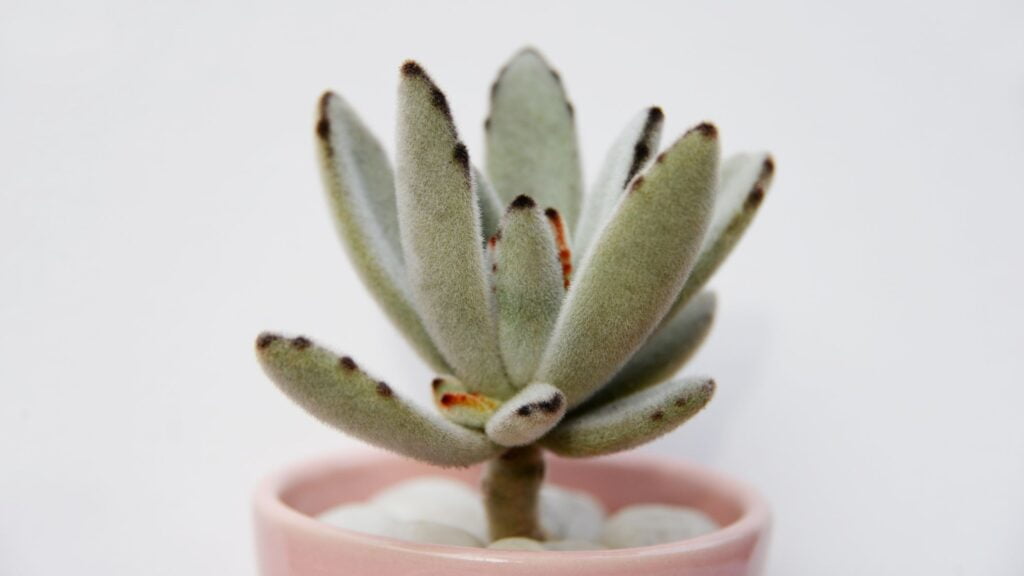
Botanical Name: Kalanchoe tomentosa
Native Area: Madagascar
Common Name: Chocolate soldier plant, panda plant, pussy ears, velvet leaf kalanchoe, plush plant, teddy bear cactus, cocoon plant
Soil Type: Well-draining
The indoor panda plant is a resilient succulent that makes a unique addition to your indoor plants without sunlight collection. Growing Kalanchoe panda plants are a good specimen to place in a child’s room as part of the décor because they are often a favorite of children.
The plant’s leaves are grey-green with chocolate-brown borders and are covered in microscopic hairs that give it a velvety appearance.
When the panda plant is fully grown, it looks beautiful in a hanging basket or a conservatory. While they’re still young and growing, you can place them near windows or on shelves.
40. Fittonia

Common Names: Nerve plant, fittonia, mosaic plant, painted net leaf
Native Area: South America
Botanical Name: Fittonia albivenis
Family: Acanthaceae
Soil Type: Moist but well-drained
With their beautiful pink and green, white and green, or green and red foliage they can become the talk of a room. The foliage is generally olive green, with veining in a different color.
Fittonia, or nerve plant, is a striking houseplant that looks great in hanging baskets, container gardens, and terrariums. These indoor plants that don t need sun are known for their rich dark-green leaves interwoven with contrasting white or red veins, or ‘nerves,’ and are excellent for fetching a little bit of the outdoors inside.
FAQs
Do plants need UV light?
Contrary to what numerous people believe, plants don’t really require ultraviolet (UV) rays for growth. Rather, they depend on blue and red light, which are not within the UV color range. Blue rays play a vital role in producing chlorophyll production, contributing to the growth of strong stems and leaves in plants.
Does UV harm plants?
UV-B radiation has been revealed to be unhealthy for living organisms, affecting DNA, proteins, lipids, and membranes. Plants, that employ sunlight for photosynthesis and are incapable of dodging exposure to enhanced levels of UV-B radiation, are in danger.
Do all plants need light to survive?
All plants need sunlight for photosynthesis, the method within a plant that transforms light, oxygen, and water into carbohydrates (fuel). Plants need this fuel in order to develop, bloom, and grow seeds. Without sufficient light, carbohydrates cannot be simulated, the energy reserves are drained and plants die. Plants that are able to survive in little to no light are the hardiest ones, they can store energy whenever they get the opportunity for harder times, but they too will die if the light stress is constant.
What light do plants need without sunlight?
Fluorescent lights are perfect for plants with low to medium light needs, like Aloe vera. They are also suitable for growing vegetables indoors. These lights generally come in lengthy, tubelike bulbs in a spectrum of sizes including T5, T8, and T12.
Can plants grow with artificial lights?
Supplementary electric lighting is one of the most effortless and least expensive ways to deliver enough light for plants that do not acquire sufficient natural light. Artificial lighting, if correctly designed, lets plants be cultivated indoors in nearly any environment.
Conclusion
If you are still unaware that your plants will survive indoors without sunlight, think twice! There is no bridge you can’t cross. We have listed 40 indoor plants that don’t need sunlight and will bring outdoor vibes into your house!
Care for these plants will depend upon their varieties, although most of them don’t need a green rule of thumb.
Let us know which plant you think will go best with your home decor in the comments section below.
Related Articles
- Propagating Chinese Elm Bonsai Cuttings And From Seeds
- Best Chinese Elm Bonsai Soil and Fertilizer.
- Troubleshooting Common Problems With Chinese Elm Bonsai
- Buy Chinese Elm Bonsai: How Not to Get Scammed When Purchasing a Chinese Elm Bonsai Tree!
- Chinese Elm Bonsai Pruning And Styling.
- Creating a Chinese Elm Bonsai Forest- Step-By-Step Guide.

